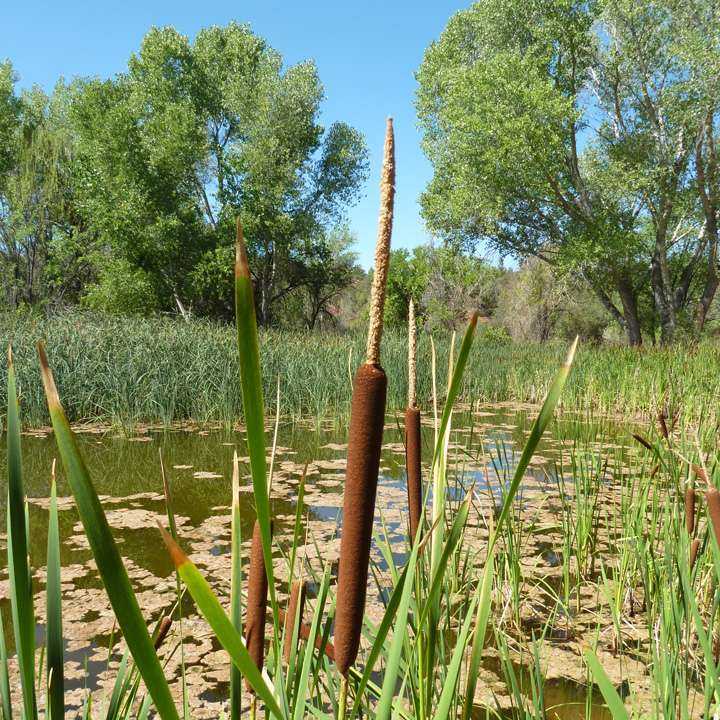Typha
|
Family: Typhaceae |
Plants of fresh to slightly brackish wetlands, often emergent. Rhizomes at base of erect shoots, mostly horizontal, unbranched, to 70 cm 5--40 mm, starchy, firm, scaly. Erect shoots vegetative or flowering, single at rhizome apices or arising from shoot bases, thus clustered, unbranched, to 4 m, elliptic in cross section; stems often somewhat compressed distally, aerenchyma absent. Foliage leaves persistent, intergrading proximally with scale leaves, to 15 on each flowering shoot; blade twisted into loose helix, mostly slightly oblanceolate, thickly concave-convex or plano-convex proximally to thinly plane distally (abaxially keeled in the Old World Typha. eleiphantina Roxburgh); mucilage-secreting glands numerous in adaxial surface of sheath and sometimes proximally on blade, colorless to brown, roughly rectangular. Inflorescences: staminate scales shorter than or exceeding flowers; pistillate spikes usually persisting into winter, when dry fruiting flowers often falling in masses; pistillate bracteoles absent or numerous, colorless except for brown apical blade at spike surface, filiform, blade club-shaped to lanceoloid. Staminate flowers: anthers dehiscing longitudinally, 4-sporangiate. Pistillate flowers: pistil hairs colorless and wholly filiform, or apically enlarged and brown, exceeded by stigmas; carpodia obovoid, spongy, bearing rudimentary styles. x = 15. Typha is ecologically important in many fresh to slightly brackish wetlands, often emergent in up to 1.5 m of water. Each spike may produce hundreds of thousands seeds, which are efficiently wind-dispersed and germinate on bare wet soils or under very shallow water. The seedlings rapidly form clones by means of rhizomes in the first season, flower the second season (R. R. Yeo 1964), and often form very large, persistent, often monospecific stands. Some species produce large amounts of biomass, comparable to the most productive agricultural crops. The three species are ecotypically well differentiated in North America (S. J. McNaughton 1966). Some mechanisms of competition between Typha species were studied by J. B. Grace and R. G. Wetzel (1982) and J. B. Grace (1988) (cf. Thieret and Luken 1996; , J. B. Grace and J. S. Harrison 1986). Common teratological forms are longitudinally split pistillate spikes (caused by parasitic insects), pistillate spikes interrupted by zones of naked axis, and partially merged pistillate and staminate spikes. The larger Typha species and T. glauca can be serious weeds in managed aquatic systems worldwide, where they can invade canals, ditches, reservoirs, cultivated fields, and farm ponds; they can be a nuisance in recreational lakes; and they can reduce biodiversity and displace species more desirable for certain kinds of wildlife (J. B. Grace and J. S. Harrison 1986; J. F. Morton 1975; J. W. Thieret and J. O. Luken 1996).
Hybrids: Putative hybrids among the three North American species have been experimentally produced and occur in most regions of sympatry and have been experimentally produced (S. G. Smith 1967, 1987). Local studies were provided (J. R. Dugle and T. P. Copps 1972; T. M. Tompkins and J. Taylor 1983). Protogyny and slight differences in flowering dates favor interspecific pollination. Hybrid seedlings are likely wherever two species form mixed stands and bare wet soil is available for seed germination and seedling establishment. 1) T. latifolia T. angustifolia (=T. glauca Godr., pro sp.), often called 'hybrid cattail,' is abundant throughout most of the region of sympatry of the parents except along the southeast coast, where it is uncommon. Almost all plants are putative ff1s which are intermediate between the parental species in all morphologic characters studied and are highly sterile, producing very few or no seeds or viable pollen grains. Fertile or sterile intermediates between T. PLANT: Tall monoecious perennial herbs of aquatic and swampy habitats. STEMS: extensively creeping rhizomes, bearing erect flowering stems, these jointless, simple, cylindric, pithy. LEAVES: alternate, sessile, elongate‑linear, equaling or exceeding the inflorescence, rather thick and spongy, glabrous, the bases sheathing, tapering to scarious or membranous auricled sheath apex. INFLORESCENCE: terminal, densely crowded elongated cylindrical spikes, with staminate flowers above and pistillate below. FLOWERS: very numerous, sessile, naked except for subtending capillary hairs, anemophilous; staminate flowers ephemeral, interspersed with numerous slender simple or forked hairs, or with linear to linear‑lanceolate bracts; stamens 2‑5; filaments free or united; anthers linear, basifixed; pistillate flowers brown, persistent on stout to almost hair-like -compound pedicels- (apparently the fusion of various pedicel bases), these 0.5‑2 mm long, interspersed with sterile flowers and slender slightly clavate bracts; fertile flowers with a 1‑carpellary pistil, the ovary 1‑celled, with a single ovule; style linear, the stigma linear‑lanceolate; sterile flowers much longer than the fertile ones, on elongated hairy stipes that terminate in a swollen, aborted ovary. FRUITS: long stalked, minute nutlets, dry, tardily dehiscent, buoyant. SEEDS: albuminous, striate, with mealy endosperm. NOTES: A monogeneric family, 9‑10 spp., widely distributed in temperate and tropical regions. REFERENCES: Ricketson, Jon. 2001. Sparganiaceae. J. Ariz. - Nev. Acad. Sci. Volume 33(1). Characters of the family. 10, cosmop. Gleason, Henry A. & Cronquist, Arthur J. 1991. Manual of vascular plants of northeastern United States and adjacent Canada. lxxv + 910 pp. ©The New York Botanical Garden. All rights reserved. Used by permission. |

